chapter 14: marijuana and cannabinoids
1/53
There's no tags or description
Looks like no tags are added yet.
Name | Mastery | Learn | Test | Matching | Spaced |
|---|
No study sessions yet.
54 Terms
history of marijuana
- 5000 years ago>>>psychoactive properties recognized in China>>> extracts used for many purposes
- Brought to the West by Napolean’s troops who returned with Egyptian hashish:
“For Egyptians the hemp plant is par excellence, not for the uses they make of it in Europe or many other countries, but for its particular effects. The hemp cultivated in Egypt is indeed intoxicating and narcotic” Piomelli, 2003, p.873
what happened in the 1930s related to weed?
US Bureau of Narcotics launched major PR campaign to portray marijuana as a social menace that could destroy the youth of America
- "Those who are habitually accustomed to use of the drug [marijuana] are said to develop a delirious rage after its administration, during which they are temporarily, at least, irresponsible and liable to commit violent crimes. The prolonged use of this narcotic is said to produce mental deterioration. It apparently releases inhibitions of an
antisocial nature which dwell within the individual"
Marijuana Tax Act of 1937
discouraged all uses
Made nonmedical use illegal
A Schedule 1 Drug (DEA):
Schedule I Drugs:
- drugs, substances, or chemicals with no currently accepted medical use and a high potential for abuse
- Schedule I drugs are the most dangerous drugs of all the drug schedules with potentially severe psychological or
physical dependence
- heroin, lysergic acid diethylamide (LSD), marijuana (cannabis), CBD, 3,4- methylenedioxymethamphetamine(MDMA), methaqualone, and peyote
C. Sativa contains >120
unique...
phytocannabinoids
- Δ9 tetrahydrocannabinol
(THC)
- Main psychoactive
compound
- concentrated in the sticky resin>>>secreted by flowering tops of female plants
- THC content (and potency) varies widely
THC (1964)
- vaporizes and enters lungs in small particles
- Effective dose and latency to onset: influenced by the amount and potency of the plant used and patterns of smoking (e.g., hold duration, puff volume, puff frequency)
- Metabolized by CYP enzymes in liver: CYP2C9, CYP2C19, CYP3A4
- Metabolites: (>80):
- 11-hydroxy THC and THC-COOH
- present for more than 2 weeks in urine after a single use
- Basis for urine drug screens
- 11-hydroxy THC>>>psychoactive
more info about THC
- easily absorbed by the lungs>>> blood plasma levels rise quickly
- Blood THC levels decline rapidly after smoking>>>Elimination half-life is ~20-30 hours
- complete elimination from the body is much slower because of persistence in fat tissues (lipid depots)
Why do edibles (e.g., PO THC) hit you so hard?
- PO THC gets metabolized by the liver>>>~50% of delta-9 THC becomes 11-OH-THC
- A much higher concentration of 11- OH THC is produced PO than inhalation
- 11-OH-THC: traverses the blood-brain barrier more rapidly and is more potent
- PO THC takes 30 to 90 minutes for the initial psychoactive effect
- the resulting “high” is longer- lasting, with a peak at 2 to 4 hours after ingestion
First cannabinoid receptor in CNS identified in 1988
- CB1 receptor—widely expressed in body
- Not related to any know receptor for NTs or peptides in the brain
- brain has more CB1 receptors than any other GPCR
- expressed at low levels by many other organ systems, including the endocrine system, immune system, heart, and liver
CB receptors are...
metabotropic
- Signal via Gi:
- inhibit AC
- inhibit voltage-gated Ca2+ channels
- open K+ channels
- Very few CB-1 receptors found in brainstem respiratory centers
- Majority located on axon terminals (on
pre-synaptic cell)
- inhibit release of neurotransmitters
- THC: a partial agonist at CB1 and CB2 receptors
- CB receptors exert a powerful inhibitory effect on neurotransmitter release
CB2 receptors are expressed by...
neurons in some areas of the brain>>>lower levels than CB1 receptors
CB2 receptors are found in the...
immune system and other tissues: bone, adipose (fat) cells, lung, testes, and GI tract
CB2 receptors also expressed...
by microglia and astrocytes
- when activated by inflammatory or degenerative processes occurring in the brain (e.g., in Alzheimer's disease or MS)
CB1 receptor activation>> behavioral tetrad
1. Reduced locomotor activity
2. Hypothermia
3. Catalepsy
4. hypoalgesia
Effects are blocked by pre-treatment with CB1 antagonist
CB1 receptor activation in hippocampus leads to...
>>>spatial learning deficits in animals
- effects blocked by rimonabant
- Cannabinoids’ inhibit long-term potentiation (LTP) in the hippocampal CA1 area
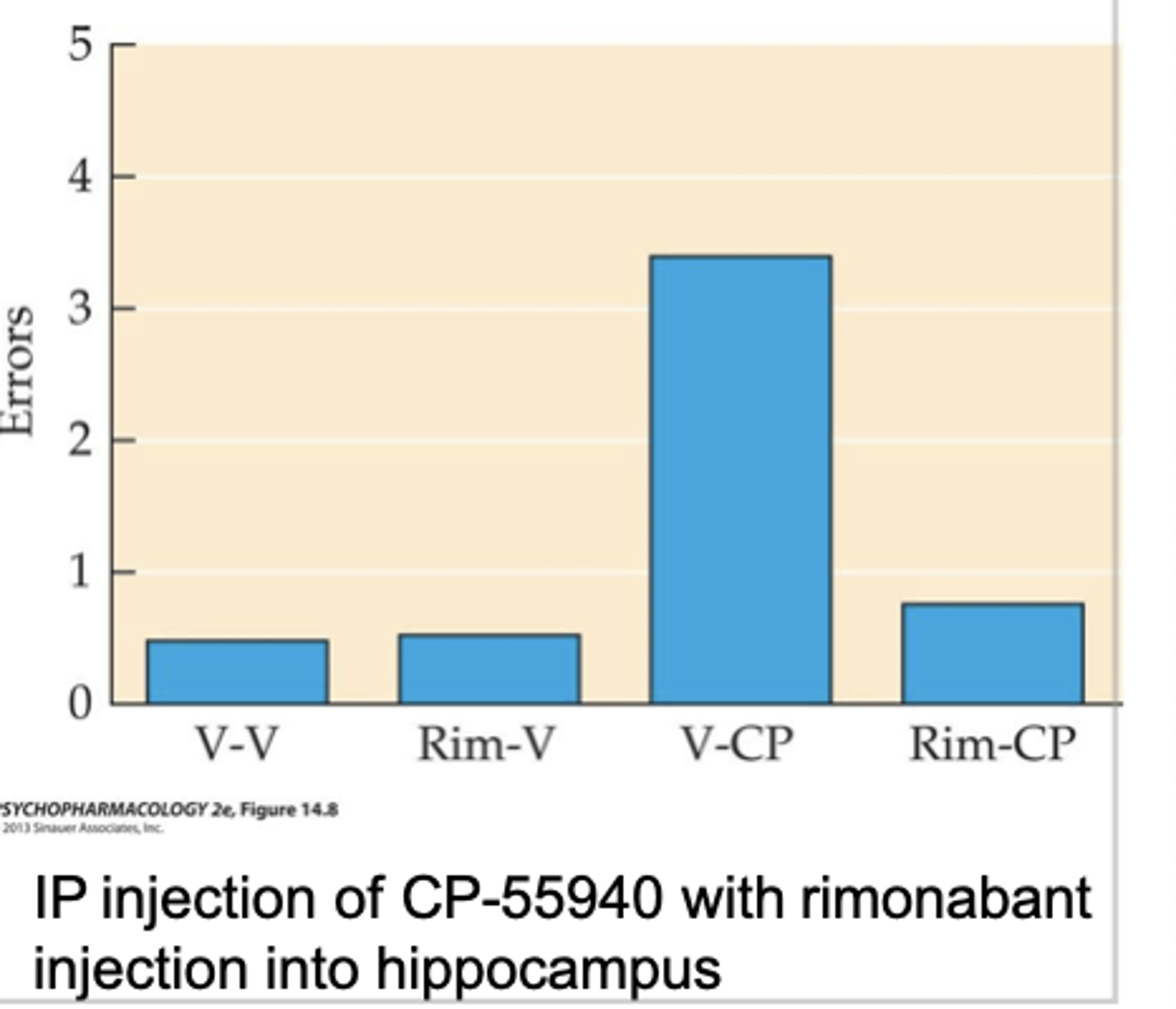
neurobiological basis for the munchies
- THC enhances incentive
motivational properties of food
- CB1 receptor antagonists reduce food consumption in animals and humans
- Rimonabant: approved as an anti- obesity medication in the EU from 2006-2008
- Removed from market after adverse psychiatric side-effects
Why do human brains have receptors for a compound made by plants?
- Must be an endogenous neurotransmitter-like substance that acts on the receptors
- endocannabinoids
Two endocannabinoids :
1. arachidonoyl ethanolamide (AEA or
anandamide)
- partial agonist at CB1
- relatively little efficacy at CB2
receptors
2. 2- arachidonoylglycerol (2-AG)
- found in much higher quantities in brain
- a full agonist at both CB1 and CB2 receptors
retrograde messengers
postsynaptic to presynaptic
Endocannabinoids
- Retrograde messengers
- Bind selectively to CB1 receptors on pre- synaptic terminal (majority)
Endocannabinoids are...
- Not packaged into vesicles
- Manufactured on demand
- Synthesized from membrane inositol phospholipids that contain arachidonic acid
- Small lipid molecules
- membrane permeable
Rise in intracellular Ca2+ >>>Ca2+ sensitive- enzymes produce them:
1. Local depolarizing event causes VGCC’s to open
2. rise in intracellular Ca2+ stores (via PLC activation)
3. Ca2+ influx via NMDA receptors
The most common and well-understood mechanism of endocannabinoid action is...
retrograde signaling in hippocampus, striatum, and cerebellum (A)
Novel signaling mechanisms:
- anandamide remains within a spine to activate either postsynaptic CB1 receptors or TRPV1 cation channels (B)
- endocannabinoids activate CB1 receptors on astrocytes
- provoke glutamate release from the cells (C)
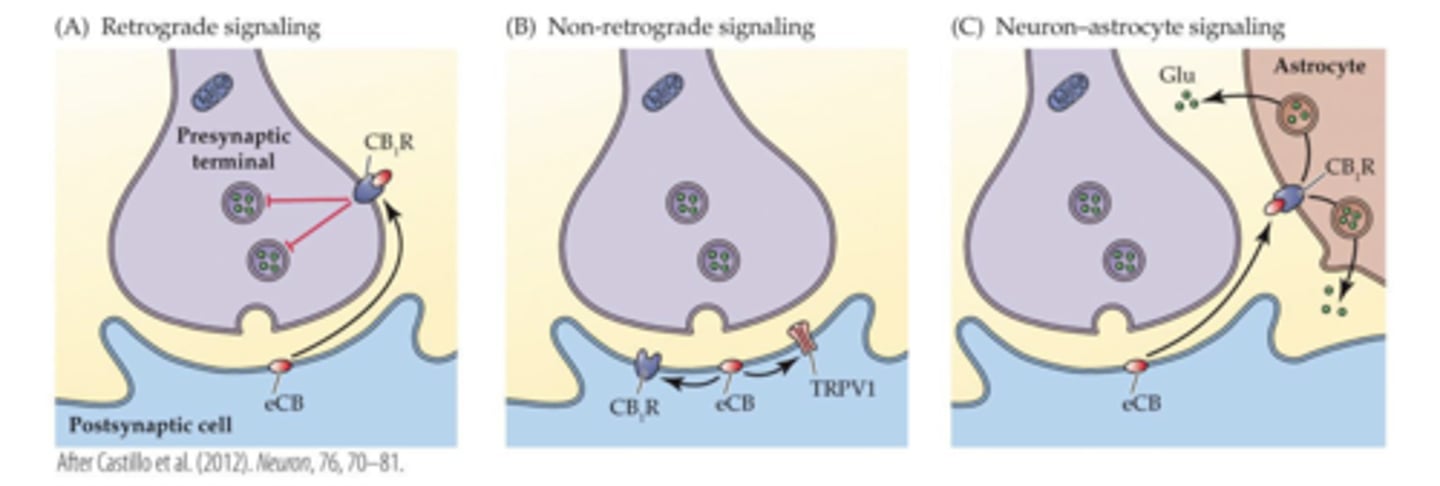
Reuptake: Endocannabinoid membrane transporter?
Metabolic enzymes:
Anandamide: fatty acid amide hydrolase (FAAH)
2-AG: monoacylglycerol lipase (MAGL)
retrograde signaling causes a type of...
short-term synaptic plasticity
When presynaptic cell is inhibitory (e.g., GABAergic)...
the effect is depolarization-induced suppression of inhibition (DISI)
In hippocampus, endocannabinoids are generated by...
pyramidal cells
- Post-synaptic membrane depolarization opens voltage- activated Ca2+ channels
>>>elevation of intracellular Ca2+ concentrations>>>2-AG
production
- diffuses to the terminals of GABAergic interneurons that normally suppress firing
- leads to a release of GABA inhibition, leading to increased firing of the pyramidal cell
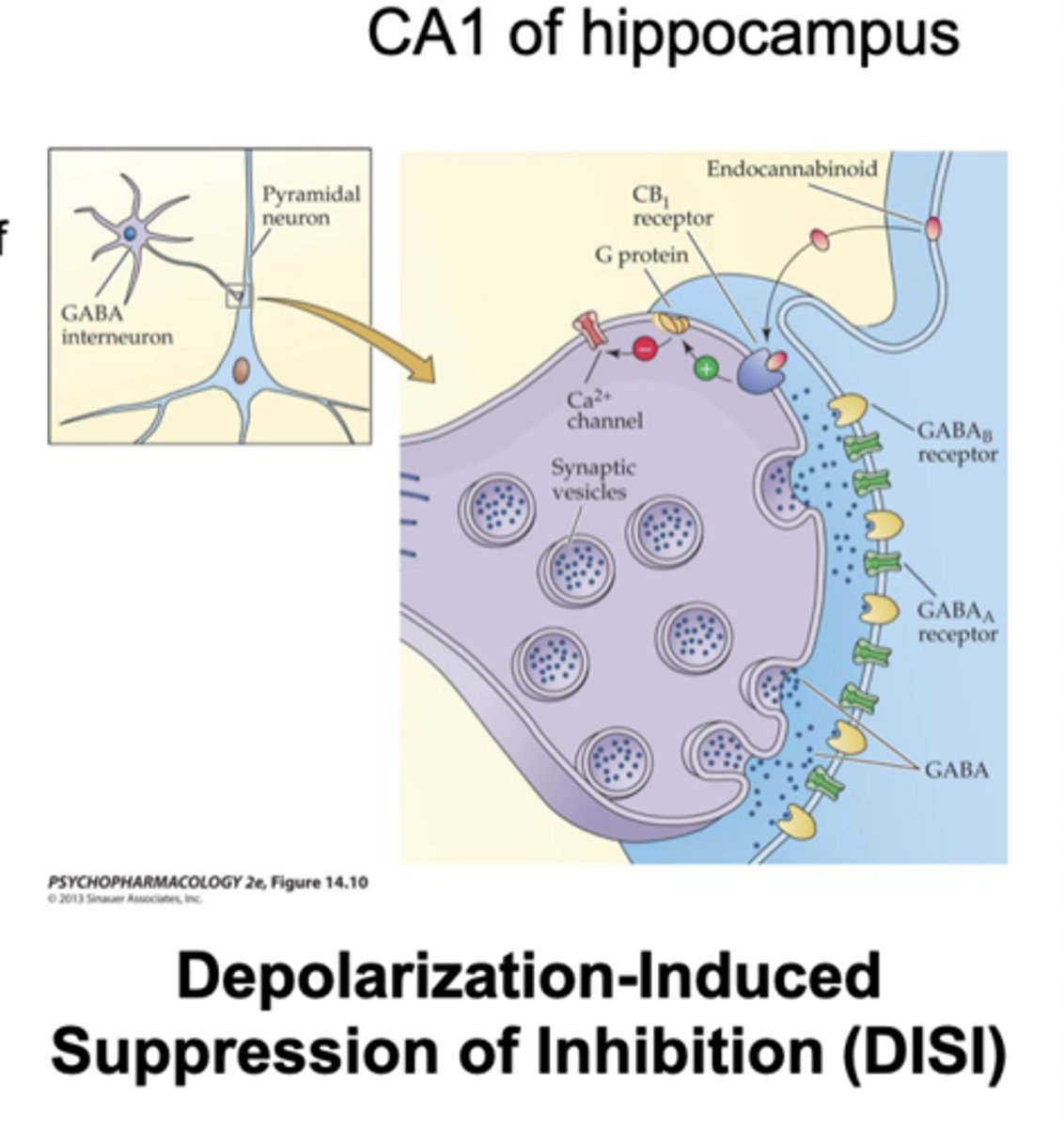
Depolarization-Induced Suppression of Excitation (DISE)
- When the presynaptic cell is excitatory (e.g., glutamatergic), the effect is depolarization-induced suppression of excitation (DISE)
- endocannabinoid (2-AG) release that starts the process is triggered by depolarization of the postsynaptic cell
In hippocampus, glutamate binds to post-synaptic mGlur5 receptors:
- Activates PLC>>>2-AG release
- 2-AG diffuses to nerve terminal and and activates CB1 receptors to reduce glutamate release
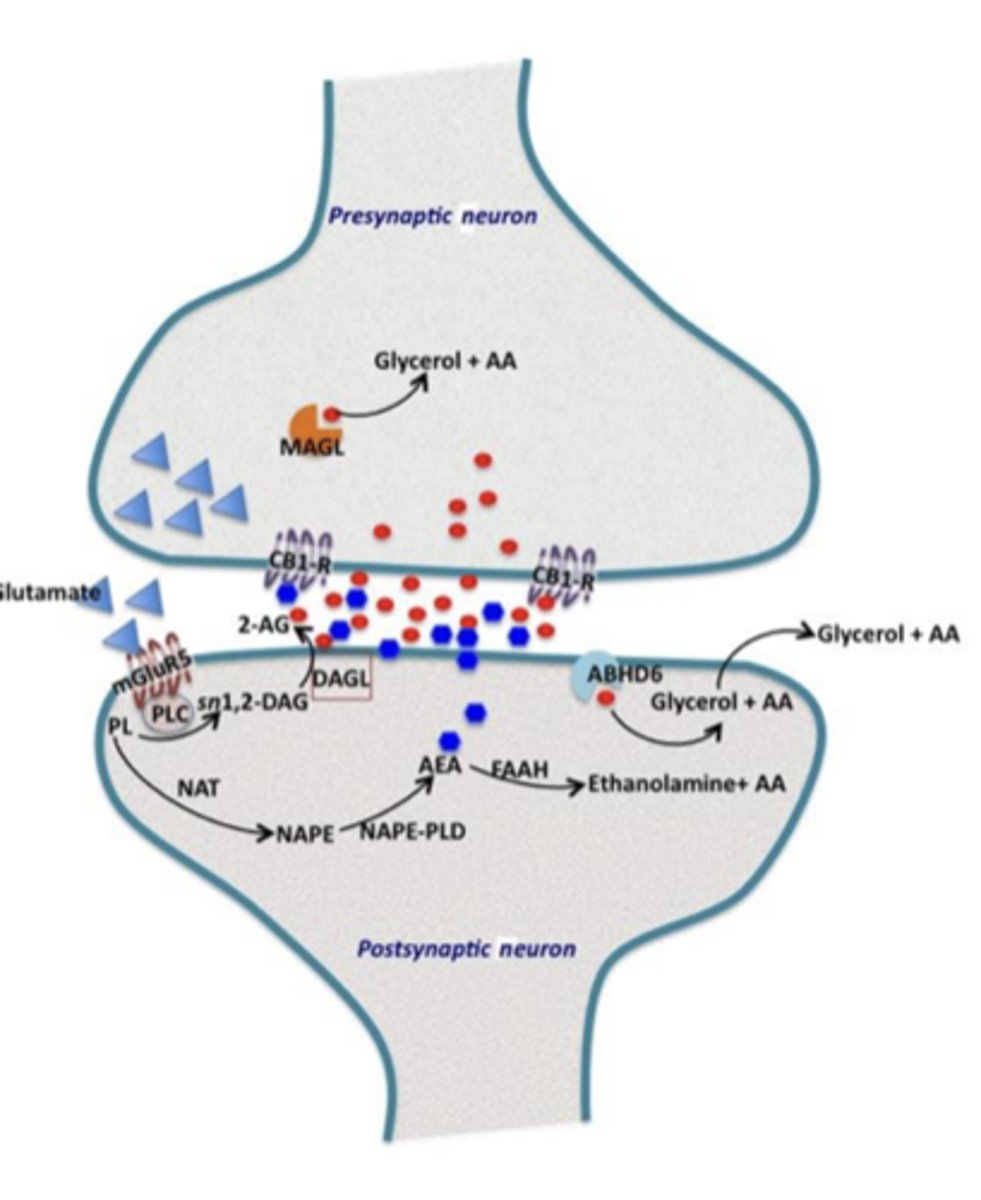
Endocannabinoids modulates...
pain perception and inflammation
- WT mice given rimonabant exhibit
hyperalgesia (increased pain sensitivity)
- CB1 and CB2 KO mice also exhibit hyperalgesia
THC given to WT mice leads to...
hypoalgesia (reduced sensitivity to pain)
- WT mice given CB1 agonists do too
- Cannabinoids are equipotent with morphine
- Robust anti-inflammatory activity of topical THC
- reduced recruitment of mast cells, decrease histamin release, decreases in myeloid immune cell infiltration
a loss of function of FAAH leads to ->
no pain
Endocannabinoids and anxiety
- Enhancing 2-AG breakdown in hippocampal glutamatergic neurons
- overexpression of MAGLin hippocampus leads to significant decrease in hippocampal 2-AG concentrations, but no change in AEA
- Leads to increased anxiety-like behavior in EPM
Endocannabinoids and fear learning:
- Endocannabinoids facilitate extinction of learned fear
responses
- Rimonabant inhibits extinction
- CB1-receptor enhancing drugs for for PTSD?
fear learning steps
Day 1: Single conditioning session
Day 2: Rx then returned to apparatus with tone continuously presented in absence of shock
- The rapid reduction in freezing behavior in the vehicle-treated group demonstrates normal extinction of the fear response
- relative persistence of this behavior in the rimonabant-treated group suggests that endocannabinoid release helps facilitate extinction of learned fear responses

Endocannabinoids and fear
learning in humans
- In humans, a SNP in FAAH gene results in increased endogenous anandamide levels
- People with one copy of hypofunctioning allele habituated much quicker to images of threatening faces
- Increased anandamide levels enhance the ability to “turn off” responses to threatening stimuli
CBD (Cannabidiol)
- Isolated by Mechoulam in 1963
- one of the 100+ cannabinoid chemicals in the marijuana plant
- Lacks psychoactive effects of THC: No longer schedule 1
- Very low affinity for CB-1 or CB-2 receptors
- May act as a negative allosteric modulator of CB1 receptors
- May function to inhibit the breakdown of endogenous cannabinoids>>>enhancing activity of the endocannabinoid system.
- May lead to activation of serotonergic 5-HT1A receptors>>> contributes to CBD’s anxiolytic effects
- May lead to allosteric enhancement of glycine receptor activity, and inhibition of adenosine uptake, thereby increasing adenosine signaling
Epidiolex
- The panel recommended approval of the drug to treat two rare forms of epilepsy — Lennox-Gastaut syndrome (appears between 3 and 5) and Dravet syndrome (<3).
- 30,000 children and adults with Lennox-Gastaut syndrome, less with Dravet syndrome
- patients continuing to have multiple
seizures/day despite medication
- Leads to at high risk for intellectual and developmental disabilities, as well as death.
- the mechanism of CBD's antiseizure
activity is not yet understood
Subjective and behavioral effects of marijuana use can be separated into four stages:
1. the "buzz,"
2. the "high,"
3. being "stoned"
4. the "come-down"
- "high" is associated with feelings of euphoria and
exhilaration, and a sense of disinhibition
- Relaxation is the most commonly reported effect of being "stoned"
Several kinds of acute adverse reactions to cannabis have been documented
- high cannabis doses can elicit feelings of increased anxiety
- elicitation of transient psychotic symptoms such as depersonalization (feeling separated from the self), derealization (feeling that the external world is unreal), agitation, and occasionally paranoia and violent behavior
- most likely to occur in first-time users, although regular users may also experience these effects if they consume an unusually high dose
- Flashbacks have occasionally been reported
- consuming extremely large amounts of cannabis, either through inhalation (smoking or vaping) or ingestion of edibles, can lead to an acute toxic reaction manifested as CNS excitation or depression, tachycardia, and gastrointestinal symptoms
- Accidental exposure to excessive amounts of cannabis most commonly occurs in children>>>. Fortunately, cases of cannabis toxicity are rarely life-threatening; most require no more than palliative care of the patient
Physiological responses:
- increased blood flow to the skin and flushing, increased heart rate, and increased hunger
- THC acts on CB1 receptors in
blood vessels
- Relaxation >>>
vasodilation
- effects are reduced by pretreatment with rimonabant
Marijuana and cognitive function:
- Most consistent acute effect of marijuana: learning and memory (e.g., immediate recall in episodic memory tasks)
- amount of prior marijuana use has been shown to influence results on some cognitive tests, with heavier use reducing the adverse effects of acute cannabinoid exposure
- led to the hypothesis that behavioral ("cognitive")
tolerance develops in heavy marijuana smokers
Reinforcing properties of
cannabinoids
- In contrast to psychostimulants or opiates, THC does not have robust rewarding and reinforcing properties
- Lever pressing by squirrel monkeys for THC stops when saline is substituted
- Lever pressing for THC is completely blocked by pretreatment with rimonabant
- reinforcing effect is dependent on CB1 receptor activation
- WIN 55,212–2, a synthetic cannabinoid and full agonist of CB1 receptor, is self-administered by both rats and mice
- produces both a CPP and a reduced threshold for ICSS
Mechanisms for reinforcement:
- Activation of the mesolimbic dopamine (DA) system
- CB1 receptor activation stimulates firing of VTA neurons in VTA and enhance DA release in NAcc
- attributed at least partly to inhibition of GABA release onto the VTA neurons by presynaptic CB1 receptors on the GABAergic nerve terminals
- opioid agonists enhance cannabinoid self-administration
- opioid antagonists have the opposite effect
An estimated _________ % of individuals who initiate marijuana use become persistent users throughout their life
5-10
Compared to casual marijuana users or non-users, these persistent users tend to experience...
a number of adverse outcomes, including more stress and less life satisfaction, more
interpersonal problems, a greater incidence of mood and anxiety disorders, and an increased likelihood of developing a substance use disorder
Regular cannabis users showed tolerance to:
1. acute intoxicating effects of cannabis, including euphoric
effects
2. cannabis-induced impairment of cognitive function
3. feelings of anxiety induced by higher doses of cannabis or pure THC
4. cannabis-induced physiological changes such as tachycardia
Tolerance to THC and cannabinoids
- largely pharmacodynamic in nature>>>a combination of desensitization and down-regulation of CB1 receptors
- rats given daily THC injections (10 mg/kg) over a 3-week period showed gradual reductions both in regional CB1 receptor density and in cannabinoid agonist-mediated receptor activation
- CB1 receptor desensitization is a result of internalization of
receptors off the cell membrane
- PET imaging studies have demonstrated widespread decreases in brain CB1 receptor binding in regular marijuana smokers
- receptor binding recovered following abstinence from
cannabis
Animal studies of chronic THC administration
- No withdrawal signs:
- long elimination half-life of THC
- Cannabinoid receptors remain partially activated
Rimonabant
- Precipitated withdrawal—rimonabant blocks the receptors and even with THC present
- Decreased DA firing in VTA and reduced DA release in NAcc
- Increased CRF release in amygdala
- increased secretion of stress hormones (corticosterone)
- animals show abstinence symptoms
FDA has...
NOT approved any medications for treatment of CUD
- Medications tried: antidepressants, anxiolytic and antipsychotic drugs, methylphenidate, lithium, gabapentin, naltrexone
- Overall, none has proven to reliably improve long-term abstinence rates
An alternative approach for treatment of CUD
treat patients with a cannabinoid receptor
agonist
- agonist substitution approach as seen in the use of nicotine-based medications for cigarette smokers or methadone for opiate addicts.
- Medications tested for this purpose: dronabinol, nabilone, and nabiximols
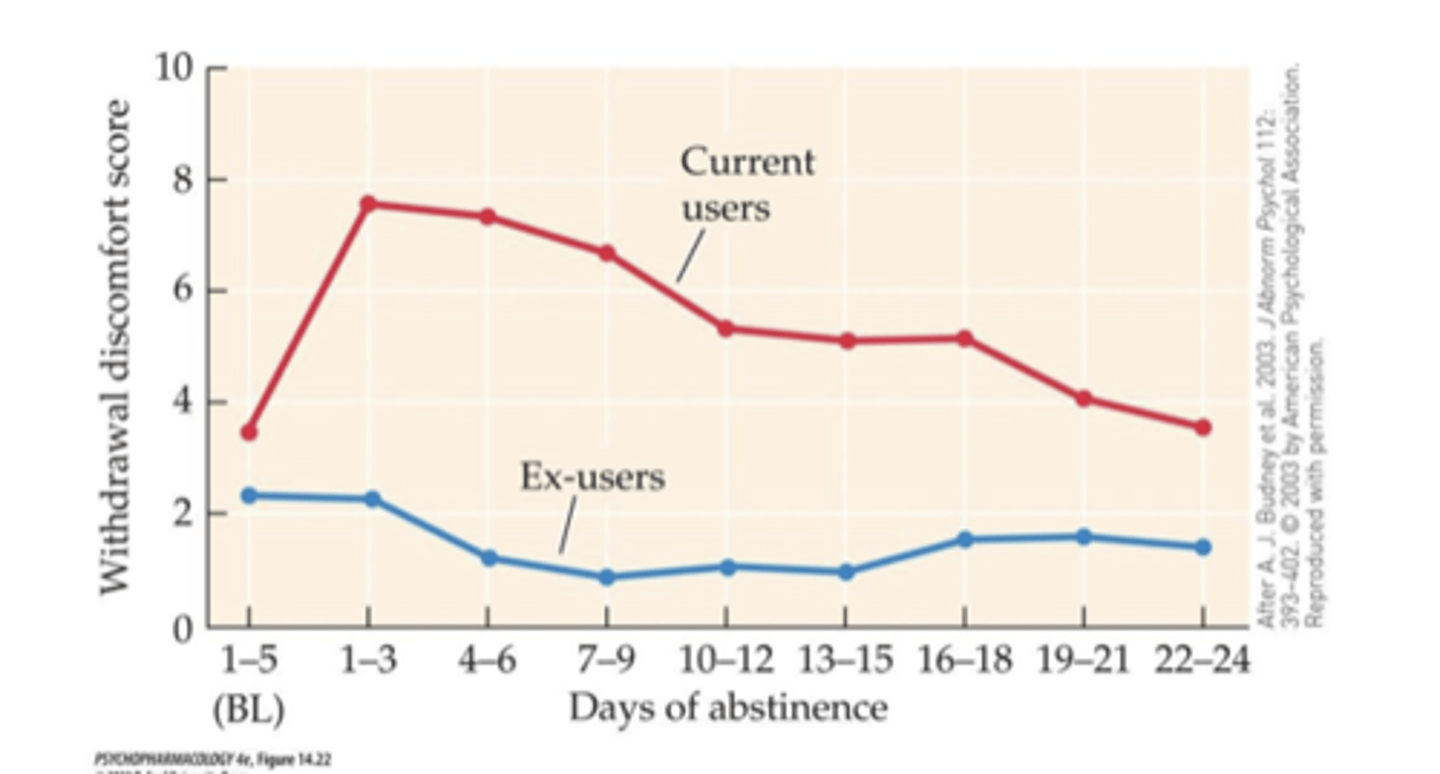
CB1 receptor activation and brain development
- Chronic treatment of adolescent rats with CP-55,940 (CB1 receptor agonist) reduced PFC dendritic length and impaired LTP at hippocampal–PFC synapses
- demonstrated deficits in prefrontal pyramidal cell dendritic development and a concomitant impairment of synaptic plasticity in the hippocampal–PFC circuitry
- these structural and functional changes may contribute to the well-known cognitive deficits associated with chronic adolescent cannabis exposure
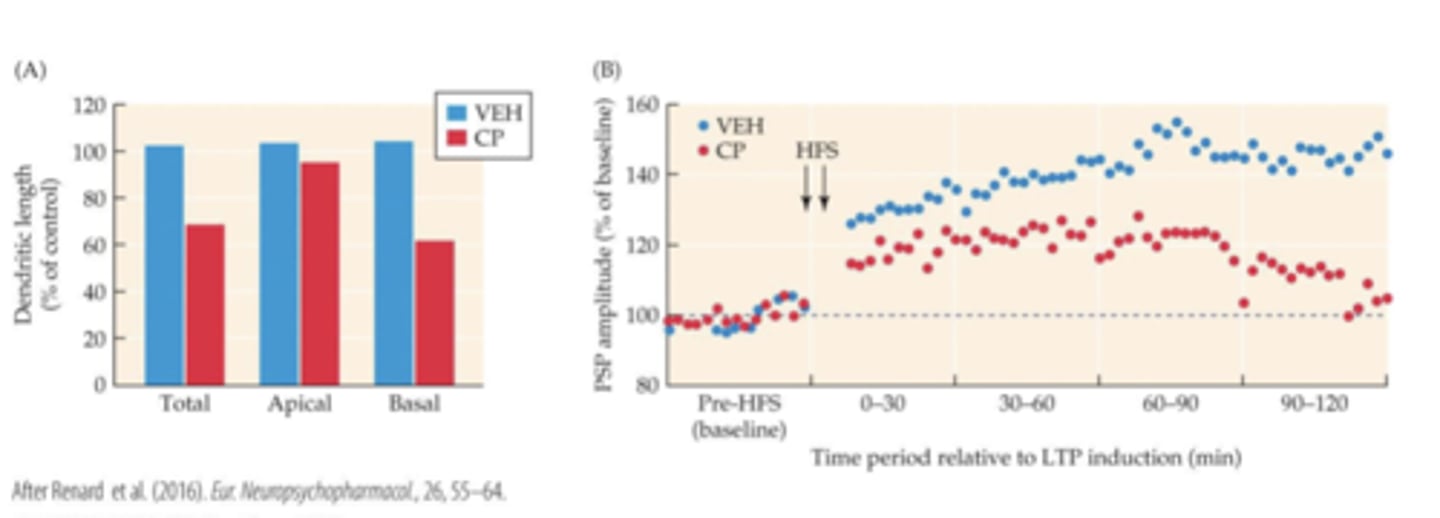
Adverse effects on health in humans:
- Structural MRI studies: regularity and/or duration of cannabis use, as well as the severity of CUD where relevant, are related to lower gray matter volumes of the orbitofrontal cortex (OFC), temporal lobe, hippocampus, and amygdala
- altered volume might reflect changes in dendritic arborization and/or synaptic connectivity.
- cannabis-related gray matter reductions could be a result of withdrawal of dendritic arbors and an accompanying decrease in the number of synapses in the affected areas
- Marijuana smoking can also adversely affect the cardiovascular and cerebrovascular systems>>associated with increased risk for atrial fibrillation, ventricular arrhythmias, heart attack and sudden cardiac death

THC and reproductive functions
- Suppresses release of LH (luteinizing hormone)
- In men, regular smoking decreases testosterone
levels and sperm counts
- Animal work: demonstrated pregnancy failure, retarded embryonic development, and fetal death with THC administration
- has not yet been reported in controlled
human studies
Synthetic designer cannabinoids – “K2”
or “Spice.”
- First appeared in 2004
- experiences similar to those produced by marijuana—elevated mood, relaxation, and altered perception
- Some users report psychotic effects: extreme anxiety, paranoia, and hallucinations
- Schedule I in 2011
- K2 od